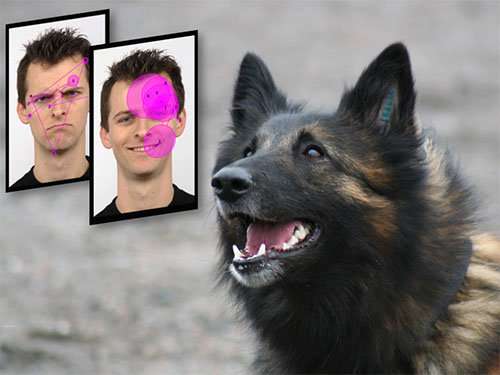Smiling human faces are attractive to dogs—thanks to oxytocin

Researchers in the University of Helsinki's Canine Mind research project found that oxytocin made dogs interested in smiling human faces. It also made them see angry faces as less threatening. Correlated with affection and trust, the hormone oxytocin is probably a key factor in the interaction between dogs and humans.
"It seems that the hormone oxytocin influences what the dog sees and how it experiences what it sees," says doctoral student Sanni Somppi.
Researchers in the Canine Mind group showed 43 dogs images of smiling and angry faces on a computer screen. Each dog was tested twice: once under the influence of oxytocin, which was administered as part of the test, and once without oxytocin. The dogs' gaze and pupil size were measured with an eye-tracking device. Emotions and attentiveness influence the gaze and regulate pupil size, making eye tracking a window into the dogs' minds.
Dogs typically focus on the most remarkable aspect of each situation, such as threatening stimuli in a frightening situation. Recognising and interpreting threats quickly is important for survival. Dogs under the influence of oxytocin were more interested in smiling faces than they were in angry ones. In addition, oxytocin also influenced the dogs' emotional states, which was evident in their pupil size.
"We were among the first researchers in the world to use pupil measurements in the evaluation of dogs' emotional states. This method had previously only been used on humans and apes," says Professor Outi Vainio, who heads the research group.
Without oxytocin, the dogs' pupils were at their largest when they looked at angry faces. This indicated that the angry faces caused the most powerful emotional reaction in the dogs. Under the influence of oxytocin, however, images of smiling faces enhanced the dogs' emotional state more than angry ones. This is to say that oxytocin probably made the angry faces seem less threatening and the smiling faces more appealing.
"Both effects promote dog-human communication and the development of affectionate relations," says Professor Vainio.
Professor Vainio's research group has previously successfully applied eye tracking and EEGs to studying the canine mind. In this study, the group partnered with József Topál, a Hungarian pioneer of canine research who specialises in dog-human interaction and the social intelligence of dogs.
More information: Sanni Somppi et al, Nasal Oxytocin Treatment Biases Dogs' Visual Attention and Emotional Response toward Positive Human Facial Expressions, Frontiers in Psychology (2017). DOI: 10.3389/fpsyg.2017.01854
Journal information: Frontiers in Psychology
Provided by University of Helsinki




















